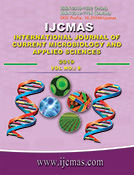


 National Academy of Agricultural Sciences (NAAS)
National Academy of Agricultural Sciences (NAAS)

|
PRINT ISSN : 2319-7692
Online ISSN : 2319-7706 Issues : 12 per year Publisher : Excellent Publishers Email : editorijcmas@gmail.com / submit@ijcmas.com Editor-in-chief: Dr.M.Prakash Index Copernicus ICV 2018: 95.39 NAAS RATING 2020: 5.38 |
White root rot caused by Dematophora necatrix is one of the most destructive soil borne diseases of apple in Himachal Pradesh. To identify the major hot spots of white root rot and to standardize the methodology for isolating D. necatrix, a survey was undertaken in three major apple growing districts viz., Kullu, Shimla and Kinnaur of Himachal Pradesh. Soil samples were collected from three most infected areas of each district. Three baits viz., kiwi leaf discs, apple leaf discs and avocado leaf discs were used separately to modify this technique followed by microscopic examination of infected baits. The results showed that in all infected soil samples collected from most infected sites of three districts, baits of kiwi leaf discs exhibited maximum infection (19.44%) of D. necatrix followed by avocado (18.89%) and apple leaf discs (8.89%). On the other hand, maximum infection of baits was observed in Ghoond area (30.00%) of district Shimla by using avocado leaf discs followed by Bhalyani area (28.33%) of district Kullu by using baits of kiwi. Whereas, minimum bait infection was recorded in Sangla area (5.00%) of district Kinnaur with apple leaf discs. Overall, the maximum mean infection (21.67%) was observed in Kilba area of district Kinnaur followed by Ghoond (20.56%) area of district Shimla and Bhalyani (19.44%) area of district Kullu. However, least mean bait infection (11.11%) was recorded in Sangla area of district Kinnaur. Therefore, keeping in view the importance of this disease, present investigation was carried out with the objective to standardize the isolation technique for quick detection and to find out the major hot spots infested by this disease.
 |
 |
 |
 |
 |